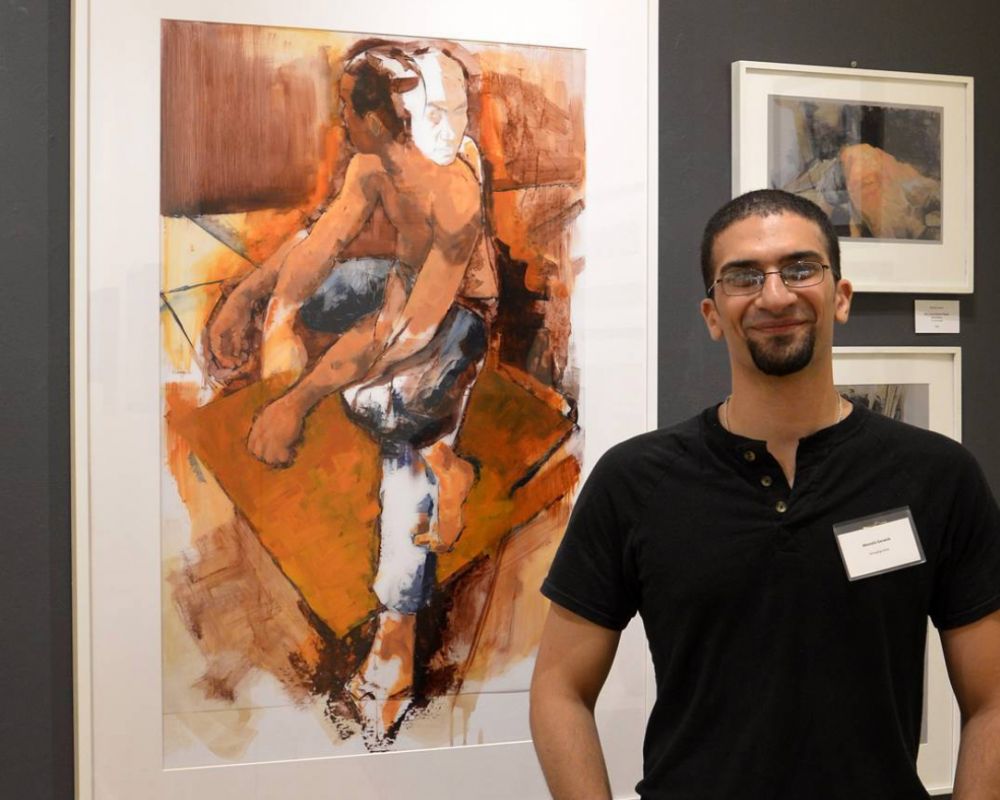STORIES FROM PAFA
Mostafa Darwish
Mostafa Darwish (BFA ’16) never expected to become an artist.
In his home country of Egypt, he pursued a computer science and business degree.
“I never did art before the age of 23. I always wanted to do art but I never had the chance because in my culture it is a completely different ballgame,” he said.
But that all changed when his family immigrated to the United States, and Darwish’s degree didn’t transfer. Faced with the prospect of starting school over again, he decided to explore art history, focusing on the intersection of art history and religion.
“I’m not religious but I was intrigued, so I took courses in Christian religion and art,” Darwish said. “I pursued art history for a concrete year and then I thought maybe I can try to be an artist so I tried community college, eventually graduating from Community College of Philadelphia but I wanted more school.”
Darwish said he was drawn to PAFA’s world-class facilities, like the Cast Hall and private studios for students. He spent his time at PAFA building up his technical skills in painting and drawing.
“I transferred to PAFA and was supposed to have two years and then I realized this is impossible for me to learn enough so I added an extra year and had two years of private studio,” he said. “When I was in school I was focusing on nothing but learning technically as much as possible.”
After graduating in 2016, Darwish started to blend the technical skills he developed in school with the ideas he had been writing down in his journal. Although he still prides himself on highly technical, figurative work, Darwish’s art now has more of a social connotation.
“I started realizing a power I had that I didn’t use was me being an immigrant and I hadn’t been exploring all of the opportunities,” he said. “Recently I’ve been trying to bring issues from the Middle East and drop them into a western society.”
Earlier this spring, Darwish exhibited his artwork at Twelve Gates Arts as part of the group exhibition, We Got Used to New Us. The show featured six PAFA graduates and examined aspects of the contemporary experience of immigrants in the United States.
Darwish was praised for his installation “Missing”. The overflowing pile of cardboard milk containers each bore a different black-and-white portrait with the same name: Mohammed. The installation comments and condemns the poor treatment of migrant worker in the Persian Gulf.
“Workers are stranded in these countries under poor living and working conditions, unable to leave the country without proof of identity. Gaining extremely little profit to survive and support their families in their native countries, many see converting to Islam as the only way to get documentation to escape their desperate situation, as employers willing to hire non-Arabic speakers prefer documented Muslim applicants. It is a requirement of those converting to Islam to choose a Muslim or Arabic name. As most of the immigrant laborers know little to no Arabic while being forced to change their names, identity, and religion, the most commonly picked name is Mohammed because it is the one most familiar and widely known,” Darwish writes about Missing.
He’s continuing to comment on social issues with the project 72 Virgins. The initiative focuses on misconceptions that have been passed down through time and have become a part of a culture.
“The whole idea of the 72 virgins is people believing that if you’re Muslim and you die without having sex before marriage then you go to heaven and have 72 females as your winning prize, which is ridiculous,” he said. “The thing is, it’s not even mentioned in the Quran. It doesn’t exist. That’s a myth that has been passed down and becomes so part of the culture and associated with being a Muslim, and it’s something that doesn’t even exist in Islam.”
This fall, Darwish will be participating in a residency at the Vermont Studio Center. Since its founding in 1984, the Vermont Studio Center has become the largest international artists' and writers' Residency Program in the United States, hosting 50 visual artists and writers each month from across the country and around the world.
“It’s a once in a lifetime chance,” he said. “I want to pursue something new to open my horizons.”
Looking ahead he wants to go back to Egypt, and see everything with a fresh eye. He said despite living in Egypt for most of his life, he’s only seen the Pyramids once.
“What if I saw Egypt and the Pyramids now and had a different eye, an eye that understands art and culture,” he said. “I would like to get back to Egypt and see how my art would change and how I would do art.”
—LeAnne Matlach (lmatlach@pafa.org)




